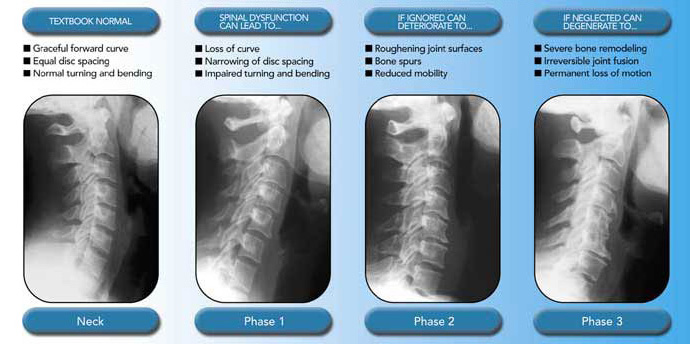Phases of Degeneration
Normal Cervical Spine
Normal curves and proper disc spacing allow normal function of the spine and nervous system. Regardless of age, when spinal damage goes uncorrected, the body deposits calcium on the surface of adjacent bones that aren’t moving property. If neglected long enough, this splinting effect can result in complete fusion. This worsening process is called Subluxation Degeneration and can occur throughout the spine. Researchers recognize several phases of spinal decay:
Phase One Cervical Spine
Loss of normal curves and nervous system dysfunction result from uncorrected spinal trauma. Usually seen as the misalignment and malfunction of the spine. Normal spinal motion, curves, and disc spacing are altered. Because the body is so adaptable, this early phase can exist without the warning of pain or other symptoms. If left uncorrected, the degeneration continues.
Phase Two Cervical Spine
Bone spurs and abnormal bony growths distort the shape and function of the vertebrae. Recognized on X-ray views of the spine by visible bone spurs and rough edges of the vertebrae. Soft tissues, such as discs and ligaments degenerate from the lack of normal joint movement. Again, pain or other symptoms may not be present.
Phase Three Cervical Spine
After years of neglect, the improperly functioning spinal joints often fuse together. A lifetime of neglect may cause the eventual fusion of the malfunctioning joints. Atrophy, permanent nerve damage, and soft tissue degeneration are prevalent. Reduced mobility and impaired nervous system function diminish one’s quality of life.
The Chiropractic Approach
You need not sit and passively watch your spine degenerate. Chiropractic can reduce, halt and may even reverse spinal degeneration by improving spinal balance and posture and keeping your joints, nerves and discs healthy and strong throughout your lifetime. Research has shown that the restoration of motion to a previously fixated joint leads to a restoration of normal joint function and physiology. Further, there is increasing evidence that some spinal degeneration may be reversible. Therefore, correction of a vertebral subluxation can not only attenuate and arrest this degenerative process, but can actually allow the condition to reverse itself.
In addition, Chiropractic care is essential for degenerative arthritis because of its effectiveness in regulating spinal pain. In a study in the American Journal of Physical Medicine, researchers reported a 140 percent improvement in spinal pain tolerance following a chiropractic adjustment. In a related study, chiropractic adjustments were also found to elevate circulating levels of endorphins, a powerful pain blocker released by the brain.
Prevention
The sooner chiropractic care is begun, the better. According to the latest research, the earlier the degeneration process is identified, the better chance the patient has for its arrest and reversal. Of course, the best approach to spinal degeneration is to prevent it from occurring in the first place. This means periodic spinal checkups to make sure spines are free of misalignments. Of course, anytime someone experiences a slip and fall, accident or other trauma, they should have their spine checked by a doctor of chiropractic to make sure that they are dysfunction-free.
Using a combination of proper diet, exercise, and regular chiropractic adjustments, you can have an active role in preventing damage (or slowing down the wear-and-tear process).
Being evaluated by your chiropractor even when you are pain-free can have a very valuable payoff in the later years. Healthy joints, muscle flexibility and a healthy nervous system will allow you to continue to exercise and be active, which we all know contributes to overall health. The key to a well-adjusted spine is starting early and continuing to keep your body in balance. This is a lifetime’s approach to overall wellness and health.



2 Replies to “Degeneration”
Comments are closed.